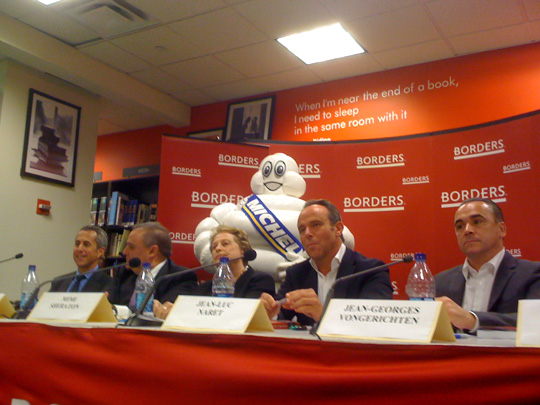 I’m a slow reader. Frank Bruni’s memoir, Born Round, is two-week-old news. I finished it yesterday.
I’m a slow reader. Frank Bruni’s memoir, Born Round, is two-week-old news. I finished it yesterday.
Let me first say what this book isn’t: a kiss-and-tell recap of Bruni’s five years as New York Times restaurant critic. There are twenty chapters, and he isn’t even offered the job until the sixteenth. There are anecdotes about the reviewing gig, most of which have been excerpted on various websites. But even if you don’t already know them, they’re not the reason for reading Born Round.
No, the book’s unifying theme is Bruni’s battle with a minor compulsive eating disorder. I have to call it minor, because he’s not Karen Carpenter, and he hasn’t had a rubber band surgically wrapped around his stomach. But he has struggled with self-loathing for much of his adult life. He would turn down dates if he was seven pounds too heavy. At his nadir in the early 2000s, he was upwards of 85 pounds overweight.
I can relate to some of this. At about the time Bruni hit rock-bottom, I was around 30 pounds overweight. Bruni solved it with relentless exercise. His willingness to endure six-mile runs and sadistic trainers is probably what saved him. For me, the only answer was deprivation. Today is a Wednesday. I haven’t had a full meal since Sunday, and probably won’t again until Friday. The only things I eat in the meantime are small snacks, and only a few of them. Despite that, I’m still the ever-elusive seven pounds away.
Before he hit bottom, Bruni tried just about everything: vomiting, speed, Prozac, starvation, Atkins, and many other dieting fads. Each step forward was countered with two steps back. He ate voraciously and indiscriminately. A maternalistic Times colleague wondered if he could become a restaurant critic without endangering his health.
Ironically, the reviewing job gave him the structure he needed. When eating 7–10 big meals per week is part of your job, you can’t rationalize it away. There’s no saying, “I’ll just go on a diet tomorrow.” There can be no diet. Knowing that there was no escape provided the motivation Bruni needed to stay in shape. The money he saved by not having to pay for his own meals went to trainers and health clubs. After five years of eating for a living, he is in the best physical shape of his life.
None of this would be compelling reading if Bruni wasn’t such an entertaining writer. He’s at his best when he’s writing about himself. Family members couldn’t possibly be as perfect as he makes them out to be. But when he turns inward, he writes with self-deprecating humor that makes even the most humdrum material stand out:
There were other problems with Prozac as well. While it diminished my sex drive only modestly, it pushed back its satiation much more substantially, so that I found myself going round and round the block without any sure sign that I’d ever get to pull into the garage. As often as not I just gave up and left my car idling at the foot of the driveway.
That has to be one of the better paragraphs about masturbation ever penned.
In case you haven’t heard, Bruni is gay. He writes volubly about his sex life, stopping only at the bedroom door: the film of Born Round will get a PG–13 rating with nothing left out. Growing up gay doesn’t seem to have caused him much trouble. Though his beloved Italian grandmother never knew, the rest of his family found out promptly before he was twenty, and he doesn’t seem to have suffered for it.
As a journalist, Bruni has led a charmed life, attracting one plum assignment after another. Writing well on a deadline comes easily to him. He’s also a dabbler. The five years he spent as restaurant critic appear to be the longest he has ever spent at anything. He is able to write about any subject on the shortest notice, which has spared him the necessity of developing real expertise. If he has a lifelong intellectual passion for any particular field, the book shows no evidence of it.
There is, of course, passion for family—gregarious, prosperous, well-fed, and relatively untroubled. There are two poignant deaths; aside from that, time with family is what makes him happiest. The lack of drama makes some of these episodes a tad less interesting than the rest of the book. After a while, many of the holiday dinners start to sound the same.
By now, it’s old news that Bruni did not have the conventional background for a restaurant critic. The book makes clear just how little experience he had. Until he was appointed Rome bureau chief for the Times—just two years before he got the restaurant gig—practically his only dining memories outside of the home were lowbrow: junk food, fast food, diners, chains and bodegas. Cold noodles with sesame paste was as close as he came to a gourmet experience, aside from an annual meal with Dad at the Four Seasons, and a steakhouse here and there.
After he got the restaurant job, the Times sent him on an immersion course in fine dining. Pierre Gagnaire in Paris—sampled on a whirlwind tour—seems to have been the only Michelin three-star restaurant he had ever tried in his life. The food was secondary on that occasion. The only memory he shares is that of dining in the same clothes he wore on the plane, because Air France had lost his luggage.
He has since been to a couple of other three-star places—none in France—which explains his bias as a critic. He waxes rhapsodic about ricotta cheese in Italy and Tyson’s chicken in Detroit, but the French restaurants are a blur. Indeed, given his lack of preparation for the job, it is miraculous that his tenure as a critic didn’t turn out a lot worse.
Ultimately, the book is about Bruni’s triumph over binge eating. The last chapter attempts to distill the lessons he’s learned. I don’t know how many readers will find themselves similarly situated. That’s not my case, as I’ve solved the problem my own way.
I found the book entertaining nevertheless. Bruni’s in his early 40s, but he’s had a lifetime’s worth of experiences. He makes them well worth reading about.
 Thursday, July 4, 2013 at 03:38PM
Thursday, July 4, 2013 at 03:38PM  After the jump, you’ll find the list of all New York City restaurants currently open, that:
After the jump, you’ll find the list of all New York City restaurants currently open, that: The two rating systems are correlated. Most of the Michelin 1-star restaurants have two or three Times stars. Most of the Michelin 2-star restaurants have three Times stars. Most of the Michelin 3-star restaurants have four Times stars.
The two rating systems are correlated. Most of the Michelin 1-star restaurants have two or three Times stars. Most of the Michelin 2-star restaurants have three Times stars. Most of the Michelin 3-star restaurants have four Times stars.



